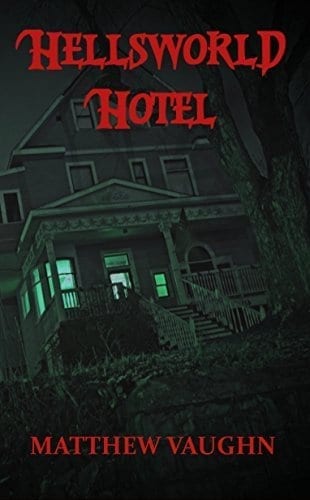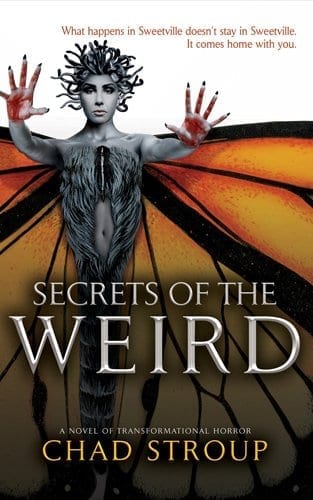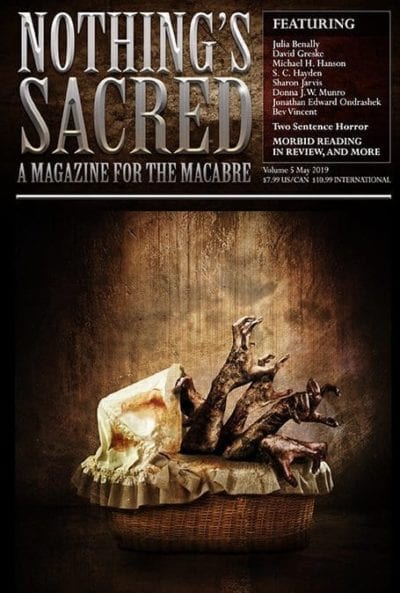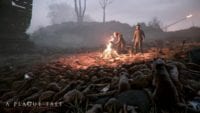Every book, movie, TV show, video game, and piece of music began with a word—a single word—one that was written, thought over, researched, stressed about, compared to others, and then re-written.
In the world of independent horror, those words—the putrid prose that drips and creeps and hides in closets and underneath beds—is the bloody business of men and women not unlike King, Koontz, or Barker. Their work drives horror in twisted ways that sometimes shocks, often defies, and most definitely deserves as much attention as any mainstreamer.
The material ranges from the macabre and otherworldly to the familiar tropes that we can’t seem to get enough. Some of their pages run wet with gore and grue so thick you can feel it beneath your fingers; others with just the right amount of information to send your brain off on a downward spiral as it fills in the remaining details on its own.
To the masterminds behind indie horror fiction, very few things are off-limits.
These Stories Have to be Told, Even if it’s Just to Myself
Most indie authors don’t ply their trade in hopes of getting rich quick; it’s simply to get the voices out of their heads. While commercial success would certainly be a welcome prospect, the thought of it not happening isn’t enough to dissuade them. Names such as Brian Asman, Matthew Vaughn, and J.G. Faherty will keep bellying up to the bar, carving out time where they can to carve up characters in their novellas and anthologies, all to the delight of the those that have supported them throughout their careers.
The realm of indie-crafted literature is a ghoulish playground built by scribes who are often allowed to spill their guts just as they see fit, without fear or restriction. “These books aren’t written with a bank balance in mind. They’re written with a passion for the genre and for the written word,” says J.R. Park, an author and owner of small publishing house Sinister Horror Company. “Indie authors and those with small presses are freer to experiment,” Park continues. And experiment they will, with storylines that houses like Simon and Schuster wouldn’t dare touch.
While one would think the backing of the mainstream publishers may seem to all but guarantee success, the freedom to create as one wants is a luxury that isn’t always available when major players control the purse strings. Horror Writers Association (HWA) member and 2x finalist for the prestigious Bram Stoker Award J.G. Faherty understands and appreciates the satisfaction that comes when writing without compromise: “There’s no editor or publisher telling you this or that needs to be cut out because the book isn’t commercial enough. You can push the envelope right off the cliff.” That hands-off approach affords the opportunity to ink whatever strikes the author’s fancy. “I write the story that comes to my head,” continues Faherty. “That could be zombies, vampires, ghosts, monsters, weird fiction, supernatural suspense, gothic, anything.”
Writers write; that’s their bag, man. Whether a million people read those words or just a loved one over coffee, the size of the audience is inconsequential. It’s the love of the game that keeps them hammering out horrors. Says Brian Asman, author of the demon apocalypse comedy I’m Not Even Supposed to Be Here Today, “The best part of being a writer is the writing. That’s it. Nothing’s better than sitting and playing with sentences. If something gets published that’s obviously nice, but that’s the icing on the cake.”
When True Inspiration Strikes, I Find the Time
 Nine-to-fivers, entrepreneurs, parents, fathers, mothers, grandparents even— these are the driving forces behind today’s indie horror scene. It only takes a vision, a commitment to the craft, and the time to write it all down. “I work full-time, pretty much about 55 hours a week at my regular job. I have to fit writing in wherever I can. I used to keep pocket-sized notebooks with me and write where there was any spare moment,” states Matthew Vaughn, whose latest release, Hellsworld Hotel, has been garnering acclaim.
Nine-to-fivers, entrepreneurs, parents, fathers, mothers, grandparents even— these are the driving forces behind today’s indie horror scene. It only takes a vision, a commitment to the craft, and the time to write it all down. “I work full-time, pretty much about 55 hours a week at my regular job. I have to fit writing in wherever I can. I used to keep pocket-sized notebooks with me and write where there was any spare moment,” states Matthew Vaughn, whose latest release, Hellsworld Hotel, has been garnering acclaim.
C. Derick Miller understands this juggling act just as well as any of his literary peers. His story “Hell Paso” was featured in Death’s Head Press And Hell Followed anthology, a collection of horror shorts that peaked at #1 on Amazon’s list of top-selling anthologies. He’s also penned additional works, with his most recent, Extinguished, having just secured publishing rights. When not writing, he’s keeping the lights on by clocking 40 hours a week in the fine art industry, as well as freelancing for a newspaper and magazine. Says Miller, “When true inspiration strikes, I find the time, even if that means burning the midnight oil.”
A few minutes before heading to the salt mines, an hour or two in the afternoon, maybe a precious few chunks of time wrestled away from the demands of the outside world on a Saturday evening; as much as Rome wasn’t built in a day, neither is dark fiction. It’s pieced together bit by gory bit, nurtured by the calloused hands of Dr. Frankensteins the world over who are ready to unleash their own personal monsters upon the villagers; even if that it means it has to wait until the kids have been put to bed.
Got a Podcast? I’ll Totally Come On!
Lack of support from a major publishing house may remove the shackles of conformation, but it also means that indie authors wishing to peddle their prose have to be their own Barker. They may not do it for the money, honey, but a few bucks here and there certainly doesn’t hurt. In order to make those dollars, authors often have to do their own legwork in terms of building an audience.
As is telling of the times, social media plays a big part in the promotion of a writer’s catalog. Chris Miller, author of Trespass and The Hard Goodbye, echoes the comments of not just authors but any artist trying to make a living by chasing their dreams: “At this stage, it’s mostly social media networking. Interacting with people in groups, putting the work out there.” With recent praise stating that his title A Murder of Saints had a Shakespearean quality, it certainly seems that his strategy is working. “A cool thing is seeing reviews from the same folks on my different books saying t hey want to keep coming back for more of my stuff, and that certainly helps keep me motivated.”
hey want to keep coming back for more of my stuff, and that certainly helps keep me motivated.”
But building a brand isn’t all about likes, shares, and tweets; it’s also about setting up shop at conventions or hosting a reading with fans. HWA member Chad Stroup relates, “I like to do readings whenever I can, and I also try to table at conventions and book fairs whenever possible.” He’s been building a cult following for his first novel, Secrets of the Weird, by doing just that. J.R. Park believes in harnessing the power of brand-building through social media but also does his part to spread the word about fellow authors: “It’s important to champion anyone that you believe strongly in. I know some fantastically talented people and I like to make sure I promote them on social media.”
I Saw the Movie, but Never Read the Book
There’s a universal truth that transcends genre and it’s something we all know and believe from the moment we test its validity:
The book is better than the movie. Every. Single.Time.
Yet many forgo the literary version for the film adaptation, not realizing just how much of the source material is lost in translation when reaching for the remote instead of the paperback.
 Nathon Allen Balka sums this up expertly: “There are some authors who seemingly use an entire forest when they pen a novel. Their books are huge. How much of that story can be condensed into a 90 or 120-minute movie?” Nathon produces Nothing’s Sacred, a bi-annual magazine that compiles short stories, flash fiction, and articles with masterful artwork into a slick, well-polished publication that has built a loyal following since its inception in 2012. The magazine is offered in both digital and physical formats, and can currently be found in a handful of brick-and-mortar shops all around the country, as well as ordered directly from the publisher.
Nathon Allen Balka sums this up expertly: “There are some authors who seemingly use an entire forest when they pen a novel. Their books are huge. How much of that story can be condensed into a 90 or 120-minute movie?” Nathon produces Nothing’s Sacred, a bi-annual magazine that compiles short stories, flash fiction, and articles with masterful artwork into a slick, well-polished publication that has built a loyal following since its inception in 2012. The magazine is offered in both digital and physical formats, and can currently be found in a handful of brick-and-mortar shops all around the country, as well as ordered directly from the publisher.
While the idea of publishing a physical magazine is something that Nathon’s been keen on since 2007, the thought of doing so was not met without challenge. In years past, fabricating a physical publication would have been costly, and with the landscape of consumerism shifting from that of physical goods to digital, it’s a move that would have likely been ill-advised. Nathon states, “There is no doubt that the digital age has helped establish Nothing’s Sacred. Without such advancements, the magazine would be nothing more than a pipeline dream because I couldn’t fathom the idea of renting office space, buying all of the necessary equipment to print and assemble the publication, and then hiring all of the people required to perform these tasks.”
This sentiment is a shared one as the rise in popularity of services such as print-on-demand and digital publishing, as well as a reduction in costs associated with physical publishing, is providing more individuals and small publishing houses an outlet for their work.
Blood Bound Books—the brainchild of teacher/business owner Marc Ciccarone—has been gaining traction in the literary world for close to a decade. While the company publishes a vast array of content suited to different tastes, it’s their splatterpunk novels and anthologies that make them a favorite among supporters.
Not familiar with splatterpunk? It’s exactly the kind of content custom-made for the indie arena and can sometimes be considered even too extreme or bizarre for small publishing houses. It’s the principal on which Marc launched his brand: “To create the type of publications and content that we were not currently finding in small press circles.” Titles like Kristopher Triana’s Body Art (with accompanying coloring book!) and the latest entries in long-running series Night Terrors and D.O.A. serve to whet the appetites of the hardcore, the die-hard, and an oft-considered undeserved readership that prefers its horror a little more outside of the norm.
“Our new tagline is ‘Blood, Guts, and Story,’ and it’s the biggest reason I think our fan base sticks around. We may publish extreme content, but it ain’t torture porn. We have a story and a subversive message with our work and that sets us apart from the stereotypical shock and gore of the masses.”
We Treat Fans and Authors Fairly
Horror’s purpose is to instill a sense of trepidation; one of dread that assaults the senses and leaves the consumer aghast, reeling and clamoring for the safe and familiar. It’s an undertaking that can prove to be challenging to the artists, be them director, painter, or author, as most of what was once considered horrific is now old hat. If the underlying motivations are largely mainstream commercial success, the resultant product can be bland, cookie-cutter, or formulaic.
But the independent industry built on the backs of authors, producers, and artists is one devoid of the confines of censorship. It celebrates individuality—encourages it even. It brings together creators who aren’t afraid to try new things with a rabid fan base that’s willing to tag along in search of something wicked.
Horror is more than just movies, books, TV shows, or campfire tales spun over s’mores. It’s an all-consuming descent into madness for everyone to enjoy. What tends to separate written works from other mediums, however, is that while poring through the pages, the reader can put their own spin on a story. Imagination is a powerful thing; one that’s shaped through individual experiences, with a single book capable of being translated into a million movies; and the more you use it, the better it becomes.
“Einstein said imagination is more important than knowledge,” says Ciccarone. “And I believe that reading is one of the most powerful tools you can use to improve imagination.”


